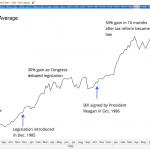Mean reversion in asset returns is a familiar subject in the academic and empirical literature, but the use–and abuse–of this core concept is all over the map. Depending on where you look, you’ll find interpretations ranging from “it’s nonsense” to a near-religious embrace of the idea that the performance cycle is all you need to know for developing robust estimates of future results. As usual when navigating through the world of finance and economics, however, reality tends to be somewhere in the middle of the extremes.
If we can’t dismiss mean reversion but can’t swallow it whole hog either, how should we deploy it? Carefully. Much depends on the details for how it’s used and the context with respect to the investment horizon. The output from modeling returns for a rolling one-year horizon the results aren’t terribly useful with a 10-year horizon, and vice versa, for instance. This is partly due to the fact that the longer the horizon, the less likely that we’ll see losses. Returns tend to mean revert around zero for one-year horizons, but ten-year performance suffers far less red ink and the reversion point is a positive return. This point looks like a deal-breaker to some eyes, but It’s a simple matter to adjust the data via, say, z-scores or percentile rank for use in practical applications.
Some folks are quick to dismiss the idea that studying mean reversion for asset returns is productive on any front, but that’s too harsh. As Vanguard-founder John Bogle observed,
reversion to the mean—RTM, the pervasive law of gravity that prevails in the financial markets—never stops. While its drumbeat is hardly regular, it never fails. For the returns of market sectors, of managed investment portfolios, and even of the market itself mysteriously return, over time, to norms of one kind or another.
The details, however, can get messy, depending on what you’re trying to accomplish. Coming up with simple rules that are universally applicable for every application is hopeless. But a bit of tweaking yields valuable perspective. By some accounts, reversion to the mean shines brightest when filtered through a valuation prism—dividend yield or price-earnings ratio, for instance. That’s certainly a useful adjustment, but let’s not abandon raw return just yet. As researchers at AQR Capital Management have noted (“Value and Momentum Everywhere”), rolling five-year return is a useful proxy for accounting-based valuation metrics.


















Leave A Comment